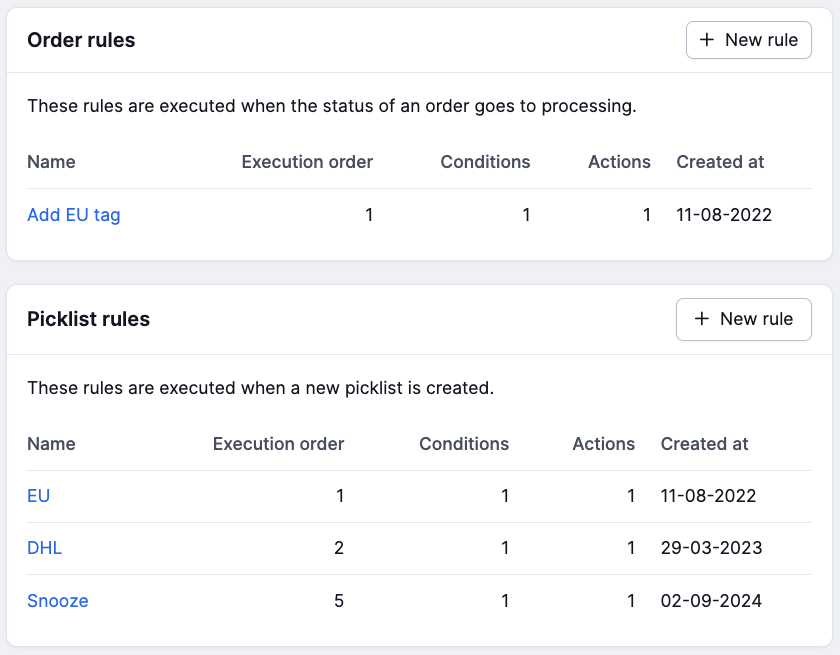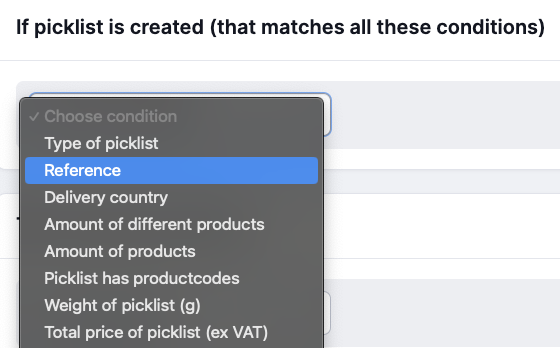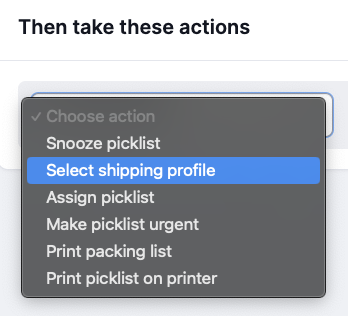How do Rules work?
On this page
Rules let you automate parts of your workflow. Based on the content of an order or picklist, specific actions can be triggered automatically. For example, you can use rules to assign a template to your order, preselect a shipping method to your picklist, or add tags to your orders.
Order and picklist rules
In Picqer we distinguish two types of rules: Order rules and Picklist rules. The type you choose depends on what you want to achieve.
Which rule should I use?
- Order rules are used for actions applied to orders. For example, selecting a template, choosing a warehouse, or adding products to an order.
- Picklist rules are used for actions related to the picklist. For example, selecting a shipping profile, printing the picklist or assigning the picklist to a specific user.
When are rules executed?
- Order rules are executed when an order moves to the “processing” status.
- Picklist rules are executed when a picklist is created.
Conditions and actions
Every rule consists of conditions and actions. A Condition tells Picqer which trigger(s) should cause the rule to run. An Action defines what should happen when those conditions are met. Each rule can contain multiple conditions and actions.
All conditions in a rule must be true. For example, if you set both ‘Delivery country is Germany’ and ‘Weight is more than 500 grams’, the rule will only run if both conditions are met. If you want a rule to apply to multiple countries, such as ‘Delivery country is the Netherlands’ and ‘Delivery country is Germany’, you can use the ‘is one of’ option.
Execution order
For every order and picklist, all rules are checked and executed if they apply. Even if an earlier rule has already set an action, a later rule will still run.
Because a later rule can override what a previous rule has set, it’s important to think carefully about the order. The execution order determines exactly in which order your rules run. Let broad, general rules run first, followed by more specific rules that can override earlier settings if needed.
A rule with execution order 1 runs before a rule with execution order 2, allowing rule 2 to overwrite the action from rule 1 if needed.
Create rule
In Picqer, go to Settings > Rules.
Here you’ll find an overview of both Order rules and Picklist rules.

Click the 'New rule' button under the type of rule you want to create.
Choose a name for this rule and adjust the execution order if needed. Click 'Save'.
Click “Choose condition”. The details you can configure for this condition will now appear.

Fill in the options for this condition and click 'Save'.

The first condition has now been added. You can add as many conditions as you like to a rule.
Choose the action that should be executed once all conditions are met.

Select the option you want and click 'Save'. Add as many actions as you like — all of them will be executed.
Logbook
In the order’s logbook (under Notes), you can see which rules were executed for that order and its associated picklists. If you think a rule isn’t working, this is where you can check whether it ran and whether another rule may have undone its actions.
Tips and inspiration
Thanks to the many options, combinations, and the flexibility in execution order, rules in Picqer offer countless ways to further automate your workflow. For inspiration, have a look at the commonly used Rules.
Rules for multiple fulfilment customers and/or delivery countries
When a rule applies to multiple delivery countries or fulfilment customers, you can choose “is one of” (default) or “is not one of” within the condition and then select multiple countries or customers.
EU as a condition
If a rule should apply to all countries in the European Union, you can select the EU directly from the list of options under the “Delivery country” condition. This way, you don’t have to select each EU country individually.
Rule condition on an empty field
To create a rule that checks whether a field is empty, use “is equal to” or “is not equal to” without entering a value. If you use “contains” or “does not contain” instead, the rule will not function correctly.
Conditions with multiple variables
For the conditions ‘Picklist contains product codes’ and ‘Delivery postcode’, you can enter multiple variables at once. Separate each variable with a comma, and Picqer will apply the rule as soon as one of the product codes or postcodes appear in the order. Keep in mind that a rule can contain a maximum of 2048 characters. To check the character count beforehand, you can use a tool like Word or Notepad.
Adding products to an order
There are two actions that allow you to add products to an order:
- "Add product by productcode": adds a product to the order at its regular sale price.
- "Add free product by productcode": adds a product to the order at a price of €0.00. Note that using this rule may cause issues for shipments outside the EU, as import duties cannot be calculated.
These actions always add a product to the order, regardless of stock levels. If the specified product is out of stock, Picqer will create a backorder. Adding an extra product may prevent the related picklist from being included in a singles batch.
If you want to add a specific product for every purchased product, it’s best to use a virtual composition. For example, adding a hanging hook for every painting sold.



